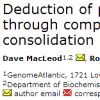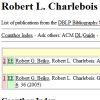| |
   
Dave MacLeod,
Robert L. Charlebois,
W. Ford Doolittle and
Eric Bapteste. Deduction of probable events of lateral gene transfer through comparison of phylogenetic trees by recursive consolidation and rearrangement. In BMCEB, Vol. 5(27), 2005.
Keywords: explicit network, from rooted trees, lateral gene transfer, phylogenetic network, phylogeny, Program HorizStory, reconstruction, software.
Note: http://dx.doi.org/10.1186/1471-2148-5-27.
Toggle abstract
"Background: When organismal phylogenies based on sequences of single marker genes are poorly resolved, a logical approach is to add more markers, on the assumption that weak but congruent phylogenetic signal will be reinforced in such multigene trees. Such approaches are valid only when the several markers indeed have identical phylogenies, an issue which many multigene methods (such as the use of concatenated gene sequences or the assembly of supertrees) do not directly address. Indeed, even when the true history is a mixture of vertical descent for some genes and lateral gene transfer (LGT) for others, such methods produce unique topologies. Results: We have developed software that aims to extract evidence for vertical and lateral inheritance from a set of gene trees compared against an arbitrary reference tree. This evidence is then displayed as a synthesis showing support over the tree for vertical inheritance, overlaid with explicit lateral gene transfer (LGT) events inferred to have occurred over the history of the tree. Like splits-tree methods, one can thus identify nodes at which conflict occurs. Additionally one can make reasonable inferences about vertical and lateral signal, assigning putative donors and recipients. Conclusion: A tool such as ours can serve to explore the reticulated dimensionality of molecular evolution, by dissecting vertical and lateral inheritance at high resolution. By this, we mean that individual nodes can be examined not only for congruence, but also for coherence in light of LGT. We assert that our tools will facilitate the comparison of phylogenetic trees, and the interpretation of conflicting data. © 2005 MacLeod et al; licensee BioMed Central Ltd."
|
|
| |

W. Ford Doolittle. Phylogenetic Classification and the Universal Tree. In Science, Vol. 284:2124-2128, 1999.
Note: http://cas.bellarmine.edu/tietjen/Ecology/phylogenetic_classification_and_.htm.
Toggle abstract
"From comparative analyses of the nucleotide sequences of genes encoding ribosornal RNAs and several proteins, molecular phylogeneticists have constructed a 'universal- tree of life,' taking it as the basis for a 'natural' hierarchical classification of all living things. Although confidence in some of the tree s early branches has recently been shaken, new approaches could still resolve many methodological uncertainties. More challenging is evidence that most archaeal and bacterial genomes (and the inferred ancestral eukaryotic nuclear genome) contain genes from multiple sources. If 'chimerism' or 'lateral gene transfer' cannot be dismissed as trivial in extent or limited to special categories of genes, then no hierarchical universal classification can be taken as natural. Molecular phylogeneticists will have failed to find the 'true tree,' not because their methods are inadequate or because they have chosen the wrong genes, but because the history of life cannot properly be represented as a tree. However, taxonomies based on molecular sequences will remain indispensable, and understanding of the evolutionary process will ultimately be enriched, not impoverished."
|
|
|
|